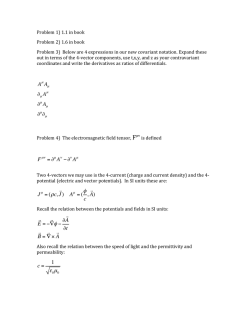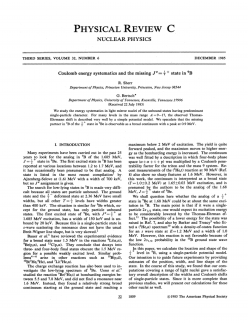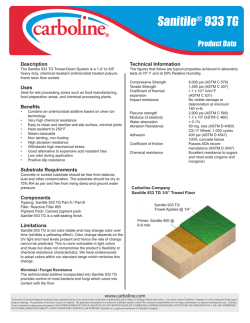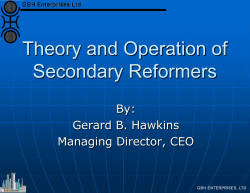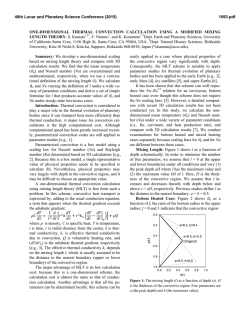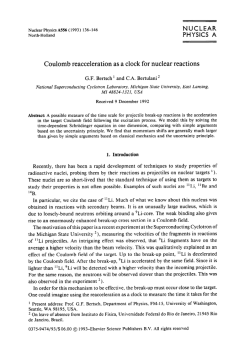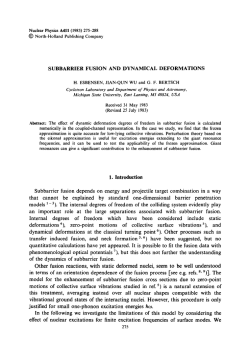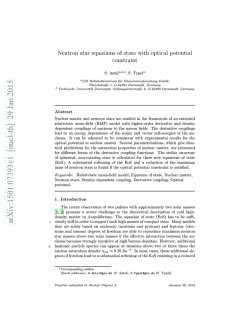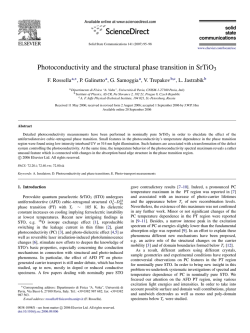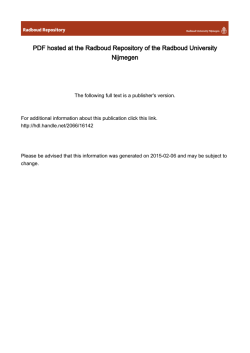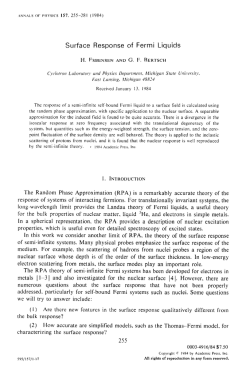
16 - Institute for Nuclear Theory
I 1.E.7
Nuclear Physics A142 (1970) 499--512; ( ~ North-HollandPublishin# Co., Amsterdam
Not to be reproduced by photoprint or microfilmwithout written permission from the publisher
SOME MODEL CALCULATIONS OF COULOMB MIXING
GEORGE F. BERTSCH t
Palmer Physical Laboratory, Princeton University, Princeton, New Jersey 08540
Received 22 September 1969
Abstract: The nucleus S6Co offers a good case for testing various mechanisms of isospin mixing.
The analog state is bound making the mixing calculation easier than for isobaric analog resonances. There is, however, a direct correspondence between the mechanisms in the bound case
and in the continuum case. The analog states of this nucleus are at low excitation so there is
hope of making detailed model calculations of all the states involved in the mixing. For these
calculations we consider the J = 0 + T = 2 state of 56Co as a simple 2p-2h shell-model state.
Four possibilities are offered for a nearby T = 1 0 + state. The external mixing mechanism of
continuum calculations is a second-order perturbation in this case which gives matrix elements
several keV in magnitude. The internal mixing caused by the off-diagonal matrix elements of
the Coulomb force has been neglected in continuum calculations, but we find that in this
case it can be comparatively large, of the same order of magnitude as the other mechanisms.
There is sufficient disparity between the matrix elements calculated for the different models to
distinguish among the models experimentally. For 56Co, experimental data can be interpreted
to give a mixing of 33 keV with a nearby state. This is large enough to exclude two of the models.
1. Introduction
T h e q u e s t i o n o f the m e c h a n i s m o f mixing isobaric a n a l o g states i n t o states o f lower
T has been given m u c h theoretical attention. T h e situation is complicated, with several
m e c h a n i s m s o f the same o r d e r o f i m p o r t a n c e . A useful f o r m a l i s m for u n b o u n d a n a l o g
states is given by M e k j i a n a n d M a c D o n a l d 1), w h i ch we hereafter refer to as M M .
T h e y give expressions for the mixing o f the a n a l o g state t h r o u g h the p r o t o n continu u m ( " e x t e r n a l m i x i n g " ) and t h r o u g h the a n t i - a n a l o g state. These two m e c h a n i s m s
are o f the same o r d e r o f m a g n i t u d e for certain nuclei. F o r b o t h mechanisms, only
the single-particle C o u l o m b field is needed to o b t a i n the isospin mixing. A third
m e c h a n i s m , m i x i n g via the off-diagonal m a t r i x elements o f the C o u l o m b force, is
c l a i m e d to be small.
I n this p a p e r we m a k e a detailed shell-model calculation o f C o u l o m b mixing for
a simple case, the first T = 2 J = 0 + state o f 56Co. H e r e the a n a l o g state is b o u n d
so t h a t it is n o t necessary t o use difficult n u m e r i c a l techniques such as principle value
integrations to calculate the external mixing. Instead, the wave f u n c t i o n distortion
c a n be f o u n d by p e r t u r b a t i o n t h e o r y or the n u m e r i c a l i n t e g r a t i o n o f the SchriSdinger
equation.
t Work supported in part by the US Atomic Energy Commission and the Higgins Scientific
Trust Fund and in part by the Air Force Office of Scientific Research under Contract AF 49 (638)-1545.
499
500
G . F . BERTSCH
Previous calculations of bound state mixing have been concerned with mixing ot
the analog into the ground state 10). This is relevant to finding Fermi-decay matrix
elements. We are concerned with mixing into states in the vicinity of the analog
state, so there is a closer relationship to the continuum calculations.
The 5 6Co analog state has a simple wave function and is at a low excitation energy.
In this situation we can hope to make microscopic models for the T = 1 state and
calculate all mechanisms of mixing within the shell model. We will consider various
likely possibilities among multiparticle-hole configurations for the T = 1 states. A
surprising conclusion that emerges is that the off-diagonal Coulomb force can be
as important as the other mechanisms in inducing mixing.
2. Mixing mechanisms
Because of the m a n y mechanisms that contribute to Coulomb mixing, some care
is needed in setting up the formalism. The procedure is to choose a Hamiltonian,
define the states in terms of it, and then treat the residual interaction in perturbation
theory. A convenient choice is the Hartree-Fock Hamiltonian of the parent nucleus.
The analog state is then defined with the T-lowering operator:
10,) =
T_IO(T, T~ = T)).
(1)
This definition of the analog state in terms of the parent is favored by Kerman
and coworkers. M M prefer to use eigenfunctions of the residual nucleus H F Hamiltonian, which do not even approximately conserve T. Having used a Hartree-Fock
Hamiltonian, the wave function will be a pure configuration. Configuration admixtures will be treated in perturbation theory, and included only to the extent that
they affect the Coulomb mixing.
In second-quantized notation, we can write the analog state as
I~.) = ,IV"Z aJm(rOajm(V)l) '
j,m
#V'-2 = E (aJm(V)ajm(Tz)a~m(ZC)ajm(V))"
jrn
(2)
Here the operator ai,,,(v) annihilates a neutron in the (j, m) orbit, and a~m(n) creates
a proton in the same orbit. The potential felt by the proton and neutron is different,
which is one of the perturbations we will have to consider in the residual Hamiltonian. We define the normalized single-particle wave function qSi(d) for the proton
distortion caused by the Coulomb field in the nucleus with T~ = T - 1 :
q~j(v) = ~qSjQt)+flq~i(d),
~2+fi2 = I.
(3)
Thus among the intermediate states that will have to be included in the calculation
COULOMB MIXING
501
IOj(d)> = d~j(d) '~ aJ(d)m(~Z)ajm(Tz)l T~ = T - 1>.
(4)
are the proton distortion states,
m
Another state which plays an important intermediate role is the anti-analog state
[refs. a,2)]. This and other "configuration states" are defined by requiring a state
orthogonal to the analog but with the same angular m o m e n t u m structure:
j
m
with
2 cj E
j
= 0.
m
Because the angular m o m e n t u m structure is the same as the analog, the central field
can mix the two. In M M it is shown that this can be a more important intermediate
state than the proton distortion states.
The states of lower isospin near the analog state we call compound states and write
[0f>- For all the models we consider later these states are simple enough to mix
directly with the analog state through the Coulomb force. The Coulomb force also
mixes 0 , with 0~; the states [0f> will mix with the anti-analog state via the offdiagonal nuclear force. To make a consistent treatment it is necessary to consider
the same off-diagonal matrix elements for the nuclear force on the analog state. Thus
besides the anti-analog, we also have to consider the intermediate states which are
T> configurations, whose anti-analogs are the 10f>. Where they exist, we denote
these by [0i).
For the matrix element between the analog and the compound states, we write the
perturbation expansion,
<¢fl Vo.10a> -- <0flVrl0a> + <0fl V,
!
gr[0a) + . . . .
E-Ho
(6)
The residual interaction can be written,
v, = Vc+ V"
(7)
The first term Vc is the entire Coulomb force, and the second term is the nuclear
interaction off-diagonal in the shell occupation numbers. The third term is the difference in the diagonal nuclear interaction from the Hartree-Fock interaction, defined
for the parent state.
Obviously isospin conservation allows only Vc to contribute to the first term of (6).
We will get a large contribution from the second term with a diagonal Coulomb
interaction and an off-diagonal nuclear interaction. There are four terms which we
consider in pairs:
502
(4'~1 v
o.F. BERTSCH
1
--
E-Ho
Vl~'a)
: I(I//f]Vc]~ ) _ _ 1
<~l/]~[Vntl~/a~>.~l//flVnt[~]~
>
1 E <[~]]~]Vc[tPa~>J
(8)
<4/°(d)l gel4/.>
-~ (~/f[ Vc[I//f(d)>If --l/f(d) <~/f(d)[Vn, [~a> "~ (~/f[ Vn[~/a(d)> Ea
Ea(d~---~
--i
F o r the first two terms, involving the anti-analogs ~bi and ~0~ we make the approximation that the energy denominators are equal and opposite. The relati_ve_positions of
the states is illustrated in fig. 1. The first two terms then reduce to (V~fV fa- Vfn~V~Ca)/
/AE. The off-diagonal nuclear force will only contribute to this sum in the isospin
combination, Ver=I)-V(T=O). This would be apparent immediately in K e r m a n ' s
c o m m u t a t o r formalism.
l~Ofld)
(d)
---V-T . . . . .
-/..
I
////
I
g'~/
T,
o
~-,
Fig. 1. Scheme of isospin mixing mechanisms. States on left are T< compound states, on right T>
nuclear states. States in middle have a Coulomb-distorted single-particle wave function, with no
definite isospin. In the shell-model formalism these states are shell-model excitations ~ 15 MeV
in excitation. In ref. 2) with an unbound formalism these states are degenerate with the analog.
The last two terms give the mixing via the distorted single-particle states. F o r
isobaric analog states in the continuum, these states are degenerate with the analog,
and a principal value integral is required to compute the second order mixing. This
is given by M M ' s eq. (4.2). In our case the distorted states have a high excitation allowing the use o f perturbation theory. The C o u l o m b part o f this perturbation will be
evaluated as
(~¢d)[ Vcl~) _ B(~'¢d)I Z a)td,(~)aj(~)l~P).
E - E(d)
The coefficient / / i s defined in eq. (3).
J
(9)
COULOMBMIXING
503
The main contribution from the term (V,- Vnv) in the residual interaction does
not come until third order in perturbation theory; via a correction to the analog anti-analog mixing. We will take this into account implicitly in calculating the
analog-anti-analog mixing, by using different wave functions for proton and neutron.
3. Model wave functions
For the test calculation in 56Co, we assume simple shell-model configurations.
Level schemes of 56Co and nearby nuclei are given in fig. 2. The analog state, lying
at 3.58 MeV, is taken as the configuration
J=0
J=0
J=0
IOa> = I ( f f l f f 1)r= l(p~ p~)r =1 >r: 2.
(lo)
Of course other configurations are mixed into this by the residual interaction making,
for example, the wave function more deformed or more like "pairing vibrations".
As noted in the last section, these will be included in perturbation theory to an approximation consistent with the model for I~Or>.
3.58
0+ [
3Me~I
~°+
,,
/I.41
24- 1.45
i+
0+ J 1.45
0"F
(2+)1
5+ ~ Ip-lh
3++ J
1M eVI
Fe54
44-
2p-2h
~ 4
Co56
2+
04-
Ni58
Fig. 2. The experimental levels in 56Co (ref. 15)). The spectrum of 54Fe (ref. 9)) and nSNi (ref. 4))
are also given. In the shell model, 54Fe is regarded as 2 holes, and 5SNi as 2 particles. Then for
2p--2h states in 56Co, the analog state is at 3.52 MeV excitation, and the lowest 2p-2h state, judging
from the strengths in two-particle transfer reactions, is the 1.45 0 ÷ state. The 2% 3%4% 5+ ground
state multiplet is understood as a lp-lh configuration.
The T-splitting of the residual interaction found from realistic interactions 3)
suggests that the anti-analog should be lower than the analog by a couple of MeV
and indeed that there is a J = 0 T = 1 state at 1.45 MeV excitation. We write for
the wave function of this state
J=O
J=O J=O
I~k~> = I(f~-lf~- 1)r= i(p~ p{)r= l>r= 1.
(11)
With only two shells active, the anti-analog is the only configuration state.
It is difficult to make a reasonable model for a T = 1 state at the excitation of the
analog. There are many possibilities, but the energetics always work out to put the
state at a higher excitation.
504
G.F. BERTSCH
One model that could be made from 2p-2h configurations is to recouple the angular
momentum within the p~ and f÷ configurations. A state of this kind, which we take
for the first model of the compound state, is
J=2
J=2
10,fl)>
[(f: 2~r= l ( p 2 h T
=
J=O
= 1)T=1
/
(12)
•
The excitation of this state relative to the anti-analog can be estimated from the
excitation of the first 2 + in 54Fe and 5aNi (see fig. 2). Adding the excitation of these
states onto the anti-analog energy gives an excitation of 4.3 MeV for the 56Co state,
which is 0.7 MeV above what we require for the compound state.
A second possibility for the compound state with a 2p-2h configuration would
be to have the two particles in a different shell. Diagonalizing the two-body interaction in the P~f~tP~r subspace gives the two lowest J = 0 states 4, 5) separated by about
3 MeV, nearly the same as the 2.77 MeV excitation of the second 0 + in 58Ni. The
mixing between shell-model configurations is quite strong, so the off-diagonal
particle-particle interaction has to be included to all orders. Specifically, we take for
wave functions in this, our second model,
J=O
J=O
[~¢a> = ] ( f ¢ 2 ) T = I ( O q l ) T = I >
d=O
J=O
T=2,
J=O
J=O
IOf(II)> = I(f£-2)r:'(0+)r=' )T=, ,
(13)
where 0 + is the ith eigenstate of the 58Ni Hamiltonian, ~'i = ~j,~ -r jq ) a- -tj m o- - t.j - m t I'~
z"
Using the force parameters quoted in r e f 4), the amplitudes for the first two states
in SSNi are:
0+
P}
0.787
P~
0.313
f~
0.532
0~
-0.600
0.188
0,778.
In this model the excitation energy of the 56Co state is the anti-analog energy plus
the excitation of 58Ni (0~-). This amounts to 4.22 MeV, higher than the analog by
0.6 MeV.
Next we consider the possibility of multiparticle-hole excitations. In nuclei near
the closed shells A = 16 and A = 40 multiparticle-hole states occur at quite low
excitation which can be parameterized by the Bansal-French formula 6). If we try the
same scheme regarding 56Ni as the closed shell nucleus, we find different parameters
for the particle-hole interaction.
Writing the monopole particle-hole force
Vph = - - a + b t l t 2 ,
the parameters at A = 40 are a = - 0 . 3 0 and b -- 2.9. To fit the lowest 2p-2h states
in 56Co, as well as the l p - l h states, requires the parameters a -- - 0 . 2 5 and b = 1.25.
COULOMB MIXING
505
The T-splitting of the interaction is not as great, making it less advantageous to couple
high T of particles and holes to low total T. A 3p-3h state of the configuration,
J = -.t-
J =-,1- s = o
IOf(III)) = I(f~- a ) r = , ( p ] ) r = ~ ) r = ~,
(14)
is predicted at an excitation of about 3 MeV above the analog state. We take this
as our third model.
For a last model we consider the 4p-4h state
J=O
J=O
J=O
IOf(IV)) = [(f~-')r=°(p~)r=°) r=*.
(15)
The particle-hole interaction parameters from 56Ni gives an excitation of 12 MeV
for this state, while if we used the 4°Ca parameters, the excitation would come down
to 4.5 MeV, as close to the analog as the first two models.
All the states except the third are anti-analogs of some T = 2 state. In other words,
the compound state could have a parent in the spectrum of 56Fe. Leoking at the
S6Fe spectrum la), 0 + levels are seen at 2.95, 3.60 and 4.30 MeV. The 2.95 MeV
state is in accord with the T = 2 energies of models 1 and II. The problem of the
energies of the T = 1 states is simply that the ground state anti-analog has to be
shifted down 2 MeV, while the excited state anti-analog has to be shifted 3 MeV.
Since the T-splitting of the lower 0 + states is anomalously low, a larger shift for the
excited 0 + states is not unreasonable.
N o n e of the four models above comes close in energy to the 3.52 MeV position
of the observed state. But it is reasonable to hope that even though the models
considered do not lie at the correct excitation, the state at that excitation will have a
large amplitude of one of the model states.
4. The single-particle
distortion
There are two active orbits, fk and p~. The distortion of these by the Coulomb
field produces an isospin mixing analogous to the external mixing of MM. The
wave function can be calculated by numerically integrating the Schr/Sdinger equation
in a Woods-Saxon well. This yields t
If,(~r)> = If,(v)>-0.0551f~(d)>,
12p~(rc)> = 0.995[2p~(v)>-0.106lpg(d)>.
(16)
The single-particle wave functions are defined with the phase convention that the
wave function is positive for r less than the position of the first node. Following the
t The author thanks Dr. W. J. Gerace for a computer program to integrate the Schr/Sdinger
equation. An accurate program is essential for finding Coulomb energy differences.
506
G.F. BERTSCH
formalism o f sect. 2, this can also be calculated as a perturbation. With harmonic
oscillator wave function, the matrix elements o f the C o u l o m b field are,
27
(lfi(i)[ 2 Vc(ij)12f}(i)) = + 1.25 MeV,
j=l
(2p~(i)] ~ Vc(ij)[3p~(i)) = + 1.52 MeV.
(17)
In this region of the periodic table the single-particle level spacing for levels of the
same spin and parity is
2ho~ ,,~ 2 x 41/A ~ MeV = 21 MeV.
The amplitude admixture in perturbation theory is then
/~t} = (f{I Vcl~>/2hco = - 0.059,
flp~ = (p~lgclP;)/2hco = - 0 . 0 7 2 ,
(18)
to be c o m p a r e d with the admixtures in eq. (15). The W o o d s - S a x o n eigenfunctions
are plotted in fig. 3 along with harmonic oscillator wave functions. F o r the f~, we
..-x
J
,
~
,
i
iI
o
j•
i
0
,o
f7/2
t
\5fm
,
i
i
/"-
i
i
I0
Fig. 3. The single-particle wave function distortions in s6Co. The solid curve is the difference wave
function between protons and neutrons; the broken curve is the harmonic oscillator state in the
standard well (me) = 11.2 MeV) with one extra node.
have agreement with the Woods-Saxon result in the amplitude of the distortion as
well as in the shape. The long tail o f the p~ makes the agreement poorer for p-waves.
We will use the perturbation result because the nuclear matrix element and energy
d e n o m i n a t o r required for eq. (8) are then easier to evaluate. The distortion f o u n d
above is in agreement with other calculations along the same lines 17), but is larger
than the estimate in the uniform model 7) by a factor of 2. The active orbits are concentrated on the surface, where the C o u l o m b field is varying more rapidly than in
the interior. The uniform model gives equal weight to the interior.
COULOMBMIXING
507
5. Evaluation of matrix elements
The matrix elements V~~ and Vff are essentially diagonal and may be expressed as
the difference of single-particle Coulomb energies,
(~O,[VIq~) = ½[(2p~l Vcl2p~) - (lf~l Vc[lf~)].
(19)
This difference was evaluated with single-particle wave functions that are eigenstates
of a Woods-Saxon well. The well was chosen to give the correct separation energy
for the p~ proton in 5 6Co ' and then the same well was used for the f÷ particle. Unfortunately the Coulomb energy difference, eq. (19) is somewhat sensitive to the
choice of well. We find QPal V c l ~ ) ~ 54 keV. Corrections to the Coulomb interaction such as the Coulomb-spin-orbit interaction, which may be of this erder of magnitude (ref. 12), footnote 9), have been neglected. By comparison, M M found that
with other shells the difference can be of the order of hundreds of keV. The result
is small in this case because the 2p~ orbit is not much larger than the f÷ orbit. Experimentally, the Coulomb displacements of the f÷ shell nuclei show that the difference
is small 16). Atkinson et al. 11) assert there is a large Coulomb difference between
2p~ and f~, but we do not find this is so with reasonable choice of well parameters.
The other matrix elements will have a rather complicated structure in terms of twoparticle interactions. Fortunately, for a given model all the required matrix elements
have the same angular momentum structure. The isospin structure will differ, dependTABLE 1
Isospin structure of interaction with compound states
Model
matrix element
I
II
III
IV
¥ VI
(%1V[~0~>
4V,
4V,
<%1 ViSored)>with
particle distorted
Vx
Vx
-- Vx
-- 111
1Io
1Io
hole distorted
~/l!-~-£V,
~-
T
4 v.
--X/~oo VI
(~a(d)] V]~0f) with
particle distorted
hole distorted
-- 1Io
-- 1Io
-- VI--f"YVo--x/-£V1T
Formulae are given in the text for the angular momentum reduction of mata ix elements in the various
models to two-body interactions. The isospin symmetry of the two-body interactions can be obtained
by a similar reduction in T-space, but for convenience we tabulate the results here. Iio and/,'1 denote
the two-body interaction between normalized T = 0 and T = 1 states. Vpp is the interaction between
protons in a normalized state. In models I and II the mixing is due to a particle-hole interaction, and
the isospin is in the particle-hole representation.
508
G . F. B E R T S C H
TABLE 2a
Two-body matrix elements for mixing calculations
Configuration
Vo
<fzlp~lvl~-lp#~
s=
V1
Vc
2
--1.837
1.367
--0.3125
3
4
5
--0.383
--0.617
0.626
0.465
0.211
0.470
--0.3188
--0.3012
--0.3371
(f~ljlV[f~lj)
J = ~
½
--0.328
--0.323
--0.479
+0.536
+0.605
+0.930
--0.3192
--0.3216
0.3237
( q q [ vIf~p~>,
J ~ 2
--0.502
0.020
--0.307
0.022
--0.823
0.041
<qql Vlp~p~>o
3
4
--0.482
5
--0.816
J = 0
In this table are listed needed matrix elements which are diagonal in principal quantum numbers.
The nuclear matrix elements are from Kuo a). Particle-hole matrix elements are given with J and
T in particle-hole coupling. The Coulomb matrix elements were calculated explicitly using harmonic
oscillator wave functions with the parameter h~o = 11.2 MeV. Units are MeV.
TABLE 2b
Two-body matrix elements needed for mixing calculations
Particle distortion
Hole distortion
(compound)
(analog)
Vo
v1
(f~-lp~.[VIf~lp~:) J = 2
--0.038
+0.308
0.146
+0.196
3
4
5
--0.114
+0.086
+0.077
+0.142
+0.088
+0.079
--0.070
0.144
+0.125
+0.066
+0.104
--0.020
j =~
½
+0.020
+0.050
+0.088
+0.131
+0.163
+0.328
+0.091
+0.105
--0.159
+0.067
+0.077
+0.251
J = 2
3
4
--0.093
5
--0.354
Configuration
(f~ljIVlf~lj)
(f~ f~] Vlf~pk)
<f~ f~lvlp~p~>
J = 0
Vo
--0.012
vl
--0.066
-0.021
--0.059
--0.005
+0.087
--0.041
11o
V~
0.022
--0.002
0.060
--0.001
0.445
Here are given the matrix elements off-diagonal in principal quantum numbers. We list the matrix
elements separately with the particle distorted and with the hole distorted. For model III the hole
distortion matrix element is different for the distortion in the analog and in the compound state.
509
COULOMB MIXING
ing on whether we are considering a Coulomb or nuclear interaction. In table 1 the
isospin mixtures entering the various matrix elements is tabulated. This can be derived
by the same technique of angular momentum algebra used for angular recoupling.
It is useful to describe the angular recoupling in more detail, taking each model
in turn. For the first model, the mixing is due to the f~-p~ particle-hole interaction,
and we obtain
(~balVl~kf(I)) = Z
U/71,~gg7,'33.0L)U(gz~2,TJ~, 2 L ) ( f ~ - l p ~ 1 2 ( V o + V 1 ) l f ~ l p e ) L
.
(20)
L
Similar expressions are valid for the matrix elements <Oal Vcl@f), <¢.1 ~/rnl~]f(d)) and
(~kf[ V.lO,(d)), with different isospin combinations. The values of two-body matrix
elements required here and below, taken mostly from the work of Kuo, are listed
in table 2.
For the second model the angular structure of ~k, and ~f are the same, so no
Racah coefficients are needed for the matrix element. The mixing is simply given by
(¢~[VlOf(ii))
.(1).(2)
=
Z
2L+1
)
- -1
J)'Wl(ff'J) LS,
(21)
where the c~° are the coefficients of the 5SNi eigenstates defined previously. The above
linear combination of interactions between the f~ and j-shells is just the ( 2 L + l )
weighed-average interaction.
TABLE 3
Coetficients of f r a c t i o n a l p a r e n t a g e for c a l c u l a t i n g m a t r i x elements to m u l t i p a r t i c l e - h o l e states
r = o
=
T=I
--0.6268
L=2
3
0.3727
--0.3274
4
5
0.6009
4. 3 ((f~z)°(f~r2)°/}f~:¢ ar = O) = ~ ]
2
4. 3
2
_
._((P~rZ)°(P~z)°[}P~;
~_
4 J = O) = 1
Evaluation of matrix elements for multiparticle-hole models requires coefficients
of fractional parentage. We list in table 3 the needed c.f.p. In model III, where we
have 3 particles coupled to T = ½, the c.f.p, were found from orthogonality to the
identical particle c.f.p., which have T = 3. These were obtained from the appendix
510
G, F. BERTSCH
of ref. s). In model 1V, we have wave functions of good seniority. Explicit expressions
are given for the two-particle c.f.p, with seniority classification also in ref. 8).
In terms of the c.f.p., the matrix element for model III is
(~[Vl~f(III))
=
3~
2o~r
x/1 ({P~}~I}(P~{P~}x)-~>
x • ({f~}~l}(f~{f2)L)~>~(2L
+ l)(f~f~[Vlf~P~>L,T"
(22)
L,T
The product of the c.f.p, for the model IV gives a factor x/~. Except for the isospin
factors, the matrix element is simply
(~k~lVI~f(IV)> = x/~<p~p~)°[ V[(fkf~)°>.
(23)
The nuclear matrix elements eqs. (20)-(23) are evaluated in table 4; and the direct
Coulomb matrix elements are listed in the first row of table 5. The indirect Coulomb
mixing given in the next rows of table 5 is found from eq. (8), using eqs. (16)-(18)
and an energy denominator for the analog state of 2.08 MeV.
TABLE 4
Matrix elements o f residual nuclear interaction in 56Co states
Model
Matrix element
I
(MeV)
II
(MeV)
III
(MeV)
IV
(MeV)
Qp~[ Vl~r)
+0.592
+0.210
--1.464
--1.122
(Ya] VI~°~)
+1.192
+0.668
OPa(a~[ VI~P*)
particle distortion
--0.009
+0.030
(V~d)lV[~0f)
hole distortion
--0.019
+0.102
--0.058
0.042
0.083
+0.238
--0.012
+0.004
--0.076
+0.014
--0.122
QPa! V!TPf<d))
particle distortion
<~pa]Vi~pt(e))
--0.770
hole distortion
TABLE 5
Contribution o f different mechanisms to Coulomb mixing in 56Co
Model
Mechanism
I
(keV)
II
(keV)
III
(keV)
IV
(keV)
direct
-- 9
-- 2
--18
+ 6
via anti-analogs
+ 12
+ 10
+30
+ 7
via distortion state
-- 2
--10
--14
+ 8
total
+ 1
-- 2
-- 2
+21
COULOMB MIXING
511
6. Conclusion
We first note that all three mechanisms give contributions of roughly the same order
of magnitude. It is then very important to know the phase relationship between the
different mechanisms, to find the total contribution to the Coulomb mixing. From
table 5 it may be seen that for the first three models there is a persistent phase relationship between the different mechanisms. The direct mixing is in phase with the
second order interaction through the distortion state. This is to be expected naively
from eq. (6) with a repulsive Coulomb force, an attractive nuclear force, and intermediate states higher in energy than the analog.
The mixing through the anti-analog tends to be out of phase. We see no obvious
reason for a particular phase here; there is a cancellation between the mixing through
the ~ and ~"states which can give a result of either sign.
From table 5 we see that the various models give quite different predictions for
the mixing strength. In particular, models I and II have small contributions which
cancel. In model III the contributions are much larger but the cancellation complete.
With the disparity in the predictions of the different models, there is some hope of
distinguishing between the models from the experimental data. This would be very
nice because the levels higher than a few MeV are not at all well understood, as was
seen from our energy estimates in sect. 3.
Recent experiments with the reactions S6Fe(aHe, t)SSCo and S4Fe(aHe, p)56Co
show two peaks at 3.521 and 3.587 MeV. The (3He, t) reaction [ref. 14)] shows a
similar angular distribution to the two states, with strengths split in the ratio 1:2.
The (3He, p) reaction 15) is consistent with this. These two reactions work quite
differently. Having the angular distributions the same and the ratio not changing
from one reaction to the other is reasonably good evidence that the analog state is
mixing with a T = 1 J = 0 + state. Assuming that the reaction mechanism just
populates the analog state, the positions of the states and the strength splittings
requires a mixing of 33 keV between the pure T states.
None of the models we calculate has a mixing this large. However, there are many
uncertainties in the two-body nuclear matrix elements, as well as the single-particle
wave functions. In particular, we de not yet know how to calculate the off-diagonal
matrix elements of the nuclear force so as to satisfy Hartree-Fock condition. The
mixing via the anti-analog, proportional to the difference in Coulomb energies
between f~ and p~, is sensitive to the details of the single-particle wave functions and
other things which make the contribution from this mechanism rather uncertain.
Also, we have not discussed the isospin-violating nuclear force. According to
Henley, this can be of the order of 4 ~ of the isospin-independent nuclear force in
the singlet S-state is). From table 2a, it can be seen that this is just the same order
of magnitude as the off-diagonal Coulomb force needed for model IV.
In view of these uncertainties, we would conclude that the first two models definitely
have too weak mixing. Model III is not ruled out, since it does give strong mixing for
512
G.F.
BERTSCH
the individual contributions. Model IV is the only one, however, that gives actual
order-of-magnitude agreement with experiment.
The author thanks Rubby Sherr for much advice and encouragement. Discussions
of the experimental data with T. Dzubay are gratefully acknowledged.
References
1)
2)
3)
4)
5)
6)
7)
8)
9)
10)
11)
12)
13)
14)
15)
16)
17)
18)
A. Mekjian and W. M. McDonald, Nucl. Phys. A121 (1968) 385
A. F. R. De Toledo Piza, A. K. Kerman, S. Fallieros and R. H. Venter, Nucl. Phys. 89 (1966) 369
T. T. S. Kuo and G. E. Brown, Nucl. Phys. A l l 4 (1968) 241
S. Cohen et al., Phys. Rev. 160 (1967) 903
N. Auerbach, Phys. Rev. 163 (1967) 1203
R. K. Bansal and J. B. French, Phys. Lett. 11 (1964) 145;
L. Zamick, Phys. Lett. 19 (1965) 580
A. M. Lane and J. M. Soper, Nucl. Phys. 37 (1962) 663;
E. P. Wigner, Isobaric spin in nuclear physics, ed. Fox and Robson, p. 442
A. de-Shalit and I. Talmi, Nuclear shell theory (Academic Press, New York) p. 295 and p. 540
Nuclear Data Sheets
J. Damgaard, Nucl. Phys. 79 (1966) 374
J. Atkinson, L. Mann, S. Bloom and K. Tirsell, Nucl. Phys. A l l 4 (1968) 143
J. A. Nolen, J. P. Schiffer, N. Williams and D. yon Ehrenstein, Phys. Rev. Lett. 18 (1967) 1140
W. Daehnick, Phys. Rev. 177 (1969) 1763
T. G. Dzubay, R. Sherr, D. Dehnhard and F. D. Becchetti, Jr., Nucl. Phys. A142 (1970) 488
T. A. Belote, W. E. Dorenbusch and J. Rapaport, Nucl. Phys. A109 (1968) 666
R. Sherr, Phys. Lett. 24B (1967) 321
J. Damgaard, Nucl. Phys. A130 (1969) 233
E. M. Henley, Isospin in nuclear physics, ed. Fox and Robson (1966) p. 3
© Copyright 2026
